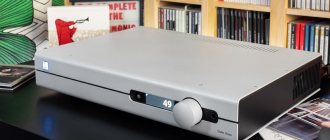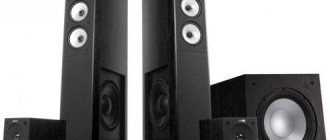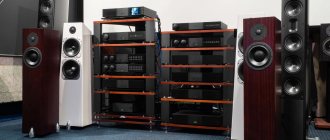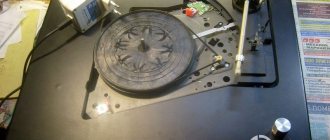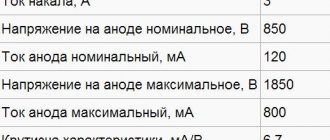Over its long history, PS Audio has released quite a few phono preamps, especially considering that new products take a long time to prepare and do not change models every couple of years. At the moment, Stellar Phono is the only corrector in the manufacturer’s catalog. In the future, we can expect a replenishment, because Stellar is not the oldest line, but for now we will study and listen to this particular model.
Save and read later -
In PS Audio, behind specific models there is not an impersonal team of developers, but a specific person who invented the device and is responsible for implementation. In this case, it is engineer Darren Myers - it is his name that is indicated on the main board of the device. The company describes the idea of this corrector as a kind of classical implementation on field-effect transistors, operating in class A.
With its own characteristics
There are no references to the “classics” in the appearance of the device. Made carefully, but without conservatism. At the same time, the device - with body panels curved at the top and bottom, as if divided in the middle - fits with all other models in the Stellar line.
The phono stage is heavy - there is a lot of metal in the external design. And the rigidity of the entire structure is quite good. The display is bright, but within reasonable limits. Even the blue-illuminated button in the form of the PS Audio logo balances on the edge of what is permitted, but does not cross it. However, what is good is that the device, switched to standby mode, has no indication at all.
At the viewing stage, there was probably only one thing I didn’t like: the simple rubber feet on which the model is mounted. However, you can easily unscrew them and use something third-party at your discretion. Or leave this moment out of the equation altogether.
The PS Audio logo on the case is also a button that wakes the device from standby mode.
The functionality of the corrector is, let’s say, more extensive than average, but with its own characteristics. There are two inputs: for MM and MC heads.
For MM heads, the impedance value is fixed at 47 kOhm and the capacitance value at 100 pF. There are several fixed impedance values for the MC input: 60, 100 and 200 Ohms, or 47 kOhms, designed for high-output MC heads. In addition, it is possible to switch to the mode of smooth channel-by-channel impedance adjustment in the range from 1 Ohm to 1 kOhm.
Gain adjustment is also relevant for both inputs. There are three positions in total, which in numbers looks like this: for the MM input - 44, 50 and 56 dB, and for the MS input - 60, 66 or 72 dB. The device does not have any other settings - for example, cutoff filters or selection of correction curves.
The management of all this functionality is implemented in an unusual way. The device has two switches. The first, on the rear panel, simply de-energizes the entire circuit, and the second is a button in the form of a logo on the front panel. Using this button, you can take the corrector out of standby mode or turn on/off the “Mute” mode. That's all.
The rest of the switching is done with a small remote control. Unusual. On the one hand, you won’t need to use this remote control often, except perhaps to switch inputs if the owner has two turntables or two tonearms on a turntable. All other settings are relevant only when changing heads, and not everyone uses this.
On the other hand, the corrector has no memory for settings - if you completely de-energize it by disconnecting the power cord or using the switch on the back, the device will turn on in operating mode via the MM input, and the other settings will also be reset. You can return everything to its place with a few presses of buttons on the remote control - everything is clear and understandable here. And it is not recommended to regularly de-energize the system - the corrector is normally supposed to be in standby mode.
So overall the implementation is unusual, but nothing more. Although my remote control sometimes worked a little thoughtfully during the test. True, after setting up the configuration, I didn’t use it, because I used one tonearm with one head - I only have low-output MCs, and there is no way to connect two of them at the same time.
There are no buttons here, these are only indicators of the current settings
Another feature: the ability to smoothly adjust the impedance for MC heads - such a separate, independent mode of operation. The adjustment here is stated to be very unusual: from 1 Ohm to 1 kOhm - smoothly, steplessly and channel by channel. Interesting.
However, when selecting heads, I would focus on fixed values, because the adjustable mode is provided simply by a pair of variable resistors, quite ordinary, and precisely stepless. It is quite difficult to accurately get into the values; the scale can be considered more conventional than informative, and adjusting channel by ear is a very delicate matter. So I would recommend fixed settings as the main mode, and adjustable settings only as an option and in combination with not very expensive heads.
A little about what's inside. The entire circuit is assembled on one large board - and assembled well. The details are decent. The division between power/control and correction is clearly visible and spaced out, although there are no additional screens. Only the power toroidal transformer is shielded, and even then it is not shielded on all sides. The power supply, judging by what can be seen, does not have voltage switching, and different transformers are used for countries with different network voltages.
Some of the transistors in the circuit simply use the bottom wall of the case as a radiator. However, the corrector does not heat up much during the process, although it certainly does not remain completely cold. But there is nothing unusual in this - everything is expected. What was pleasing: there are no operational amplifiers in the signal circuits - the circuit is based on discrete elements. The balanced output is truly balanced. The circuit with passive RIAA correction also looks interesting.
The support legs of the PS Audio Stellar Phono are the simplest
The device just out of the box takes some time to come to its senses, but then, if it is just standing in standby mode, you can turn it on and listen as usual. Everything reaches operating temperature in no more than 10–15 minutes, and in general I didn’t notice any capriciousness here.
What made me happy: with different connections, even with low-output MC heads, the corrector is quiet. There is practically no background; something minimal can be heard at a volume at which no listening is possible. And at normal volume or just significantly above average - silence. When switching modes and settings - only relay clicking, no additional artifacts.
The remote control of the PS Audio Stellar Phono is more logically called a remote control
The connectors are of high quality, the grounding terminal is convenient and is also located where it is appropriate to be. The output can be used either balanced or unbalanced - but since the balanced one was made normally, I used that one.
Phono stage PS Phono PS-II Mk5
The PS-II phono preamplifier from PS Audio (USA, 1973) is one of the best phono preamplifiers in the history of vinyl, standing next to such whales as the Yamaha A-1 and Sansui D5, included in many printed works on high-quality reproduction as an example of a top-quality preamplifier. class with unsurpassed overload capacity and high gain. The phono stage combines the most detailed sound closest to a live performance and a magnificent stage with a complete absence of artifacts in the form of background, self-noise and parasitic harmonics, which are characteristic of tube and microcircuit correctors. A completely discrete circuit assembled on 18 low-noise transistors has a passive correction circuit, which ensures excellent operation of the corrector from any source to any load, even low-impedance. The phono stage works great with any MM and MC heads with high output. Our product is an exact schematic copy of the PS Audio PS-II...with the only difference being that the appearance has been changed, parts of a higher class have been used than in the original, and a more precise and appropriate adjustment of the device has been applied. Characteristics: Sensitivity 1-6 mV Frequency response - from 15 to 90000 Hz Overload capacity - 45 dB Output voltage - 300 mV Input capacitance switchable 100-470 pF (allows the use of the corrector with ANY MM and MC heads with high output). Unlike most similar products, the proposed corrector uses a full-fledged transformer bipolar power supply with a total swing of 60 V in combination with high stabilization, which made it possible to maximize its potential. Components from Japan and Germany: Wima FKP-2, Elna Silmic II, Philips, Toshiba, inlet - multilayer ceramics Murata or Wima film. Warranty - 1 year from the date of sale. In the event of a complaint, we will cover all postage costs for exchanging the product. Delivery throughout Russia is 400 rubles, dispatch is carried out on the day of payment. —————————————————————————————— In conclusion, I would like to add that the presented corrector is more than competitive with most Hi-End phono stages of well-known brands and we can confidently assure you that by purchasing PS Phono, you will be pleasantly surprised to hear a lot of new and interesting things in the sound of your favorite records, and the search for a decent-sounding but affordable corrector will finally end. - the price is indicated for the version only with the selection of pairs of transistors and performance monitoring (for buyers with a limited budget) - with the selection of all components according to parameters and full configuration for exact compliance with standard characteristics - 17,000 rubles (recommended version) - additionally with silver soldering and Canare connectors , SMS - 20,000 rubles (18,000 for those who have already purchased a phono stage of any model from us). Reviews from people who actually bought this corrector can be read in huge numbers on Avito and Bag by inserting 335578 salesman into any search engine and then following the link that opens. Bar visitors - discount 89167413569
Lamp warmth
The first one I played was Donald Fagen's "Sunken Condos". The sound turned out to be large, voluminous, as if velvety, with a large-scale stage. The character of the presentation is cheerful, even somewhat rollicking, but without familiarity. There's definitely a warmth that would be more likely to be attributed to a tube preamp with an emphatically tube-like sound.
At the same time, there are good dynamics and more than decent detail. With all this warmth and velvety, the effect of blurring the sound is not observed. There is a lot of bass in the sound, but it also has quality and control. With also a traceable softness, there is no bad control or looseness at all.
The middle is slightly raised, open, informative. At the same time, the vocal parts are commensurate with the large stage as a whole and are well constructed, physical and well-developed in the overall volume. The high-frequency sound seems rounded, but there is no loss in speed or intelligibility, and according to hastily measured measurements there is no roll-off.
In general, with a clearly emphasized character, the sound does not feel colored - and there are not many analogies with vintage sound either. In some ways it reminded me of some amplifiers based on germanium transistors, but it only reminded me - without obvious similarities.
PS Audio Stellar Phono Rear Panel
The device keeps the rhythm well. Maybe he even forces it a little, gives in to emotions, but he does it all quite carefully, without going overboard. And at the same time, good, confident intelligibility is maintained. Only without a categorical layout of music into separate components.
The second record is Sarah Vaughan "Sweet 'N' Sassy". This disc is not in perfect condition - there are some clicks and crackles. Everything is audible, but if on many other correctors this would cause rejection or irritation, here, even with obvious audibility of artifacts, it turns out interesting - the music covers them up. First of all, not by volume, but by some kind of emotional involvement in listening. And you quickly stop paying attention to artifacts.
The recording itself here is definitely not cold, not very neutral and definitely not detached. However, there is no “overheating” with warmth or emotions - despite all the volume, softness and amount of warmth, the sound is completely devoid of sweetness. And with good attention to detail, there is no distancing from the main theme in favor of nuances and aftertones. Although the device plays back the after-sounds, but does not eat them up.
In practice, it turns out that the features of the record are clearly audible, but there is no obvious combination of them with the sound character of the phono preamplifier, and what is produced at the output is quite interesting to listen to. In general, the liveliness of presentation and involvement, in defiance of many modern correctors, especially on op-amps, can be seen very well here and presents Stellar Phono in a favorable light.
PS Audio Phono Stage PS-II Mk5
PLEASE BEFORE CLICKING ON THE "KU" BUTTONDRINK" PLEASE READ THE PRICES FOR CORRECTOR MODIFICATIONS PLACED AT THE END OF THIS ANNOUNCEMENT!!!The PS-II phono preamplifier from PS Audio (USA) is one of the best preamplifiers, standing next to such whales as the Yamaha A-1 and Sansui D5, which is included in playback theory as an example of a top-class preamplifier with unsurpassed overload capacity, high gain and a favorite more than one hundred fans of vinyl sound. Exact copies of this corrector are made according to original documentation in workshop production conditions in Moscow. The phono preamplifier combines the most detailed sound closest to live performance, typical of tube preamplifiers, an excellent stage and panorama (for example, the depth and width of the stage of tens of meters for PS is not a problem) and “transistor” dynamics with the complete absence of background, intrinsic noise and parasitic harmonics , characteristic of a “lamp”. The bass is accurate, smooth, with good texture, the mids are clean and neutral, the upper frequencies are transparent, but without unnaturalness or pretentiousness. Thanks to its high overload capacity, the corrector easily copes with any musical genre and does not sag even in the most difficult recording areas. A completely discrete circuit assembled on 18 low-noise transistors with a passive correction circuit ensures excellent operation of the corrector from any source to any load. The phono stage works perfectly with any MM and MC type heads with high output. Sensitivity 1-6 mV Gain at frequency 1 kHz - 48 dB Signal to noise ratio - 82 dB, distortion - 0.01% RIAA compliance - no worse than 0.18 dB Frequency response - from 15 to 90000 Hz Overload capacity - 45 dB Input change is provided containers for precise matching of the head with the corrector. The supply voltage is bipolar 64V. The corrector is two-block. Dimensions 2x 8.5x5x16, weight 1.3 kg Components from Japan and Germany are used: Wima FKP-2, Elna Silmic II, Philips, Toshiba (at the customer's request, input shunts are multilayer ceramics Holystone Murata or Wima film) Cases are metal. The phono stage is new. Warranty - 1 year. We ship throughout Russia. In conclusion, I would like to add that the presented corrector is more than competitive with most Hi-End phono preamplifiers of well-known brands at a much lower price and can safely assure that by purchasing the PS Phono Stage PS-II Mk4, you will be pleasantly surprised to hear a lot in the sound of your favorite records something that you haven’t heard in their sound before, and the problem of finding a decent sounding but affordable corrector will never affect you again. ————————
The price is indicated for the version with basic settings and selection of pairs of transistors. The price of the version with the selection of transistors, capacitors according to parameters and complete configuration and balancing of the arms of the output stages is 17,000 rubles.
The price of a corrector with Neutric or SMS terminals and soldering with silver-containing solder (WBT 0800 silver) is 20,000 rubles
You can read reviews from new owners in my rating
Cheerful and peaceful
Next I put on David Gilmour’s “On An Island”. Good volume, air, a lot of details can be heard. And the rhythm is good. But the specific, slightly sad and contemplative atmosphere of the album does not coexist perfectly with the character of the sound.
PS Audio Stellar Phono Internals
And not in the paradigm of light or dark sound - here everything is in order, and even a certain warmth does not contradict. However, a drop of different components - and everything turns out a little more cheerful than, as one might assume, it was intended on the recording itself.
Although this effect, of course, varies from composition to composition. These are all nuances—but interesting nuances. According to formal criteria, everything is fine. There is ample stage volume and air, speed and rhythm are in place, details are clearly audible - and the music does not fall apart. Emotions, rather, are drawn in large, distinct and fairly bright strokes, with a certain predominance of pure colors rather than halftones.
Toroidal power transformer
In terms of emotions, the Dead Can Dance album of the same name can in some ways be correlated with the previous album, but in reality, emotions are not “combed” with the same brush. The difference in shades and nuances is clearly audible.
Here there is simply wonderful volume and depth of sound, excellent bass, precise layout of space with well-readable images. Attention to each individual part does not overwhelm - and the music is listened to quite completely.
There is a moderate darkness (but it seems to be implied in the recording), but I would not say that the music is somehow changed or that, on the contrary, the existing character is too emphasized. And the share of warmth, even if noticeable, does not stand out from the general character and does not make the music different.
Then he put on a record with recordings of Couperin’s harpsichord pieces. The sound of the harpsichord is not sharp, everything is slightly smoothed out, but the sound is emotional, soulful, with good volume development and correct attenuation. The corrector does not dampen aftersounds. And somehow you very quickly get used to the sound, to its character. After all, the character, it must be admitted, is very peaceful, but not at all sleepy. And everything turns out quite balanced.
The last recording is a performance of “Carmina Burana” by Carl Orff. Quiet moments are handled beautifully. The timpani at the introduction are also very good, spacious and reliable. At some points the drama is smoothed out, but not much - this does not change the overall picture. There is almost always enough detail everywhere. There may be more, but this is also very good.
And the decline in detail does not go smoothly, when a lot is blurred, but on the contrary - up to a certain level everything is very good, and then only a very small “piece” is cut off. The stage is large, not so much airy as dense, but with correct proportions, excellent width and depth. The readability of images and plans is good. Quite interesting to listen to.
Passport details
Type: transistor MM/MC phono stage
Inputs: RCA 1 x MM, 1 x MC
Outputs: unbalanced RCA, balanced XLR
Control trigger input: 3.5 mm, 12 V
Gain: MM: 44 dB, 50 dB, 56 dB MC: 60 dB, 66 dB, 72 dB
Input impedance: MM: 47 kOhm (100 pF) MC: fixed values - 60 Ohm, 100 Ohm, 200 Ohm; adjustable values – 1 Ohm–1 kOhm
Frequency response: 20 Hz - 20 kHz ±0.25 dB
THD: at 0.5 V/1 kHz —
Signal-to-noise ratio: MM: >82 dB A-weighted. MC: >74 dB A-weighted
Channel separation: >74 dB
Power consumption: 26 W
Dimensions (WxHxD): 430x332x82.55 mm
Weight: 9.8 kg
